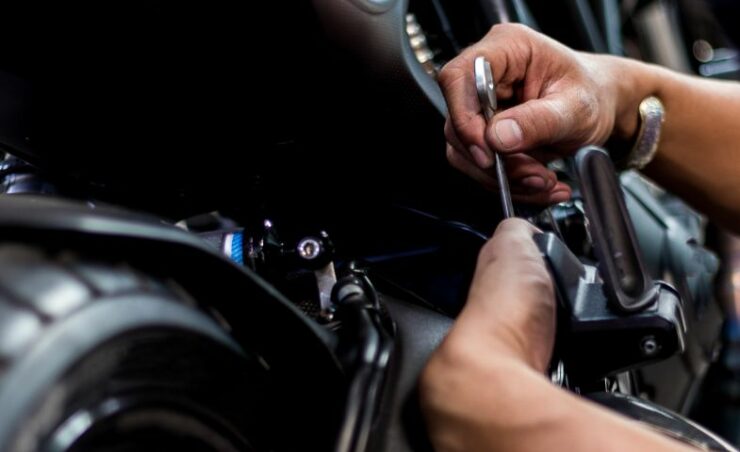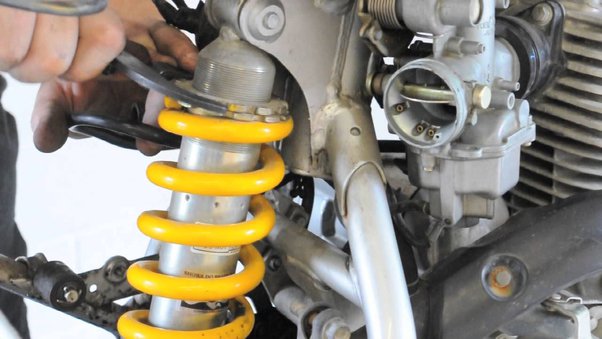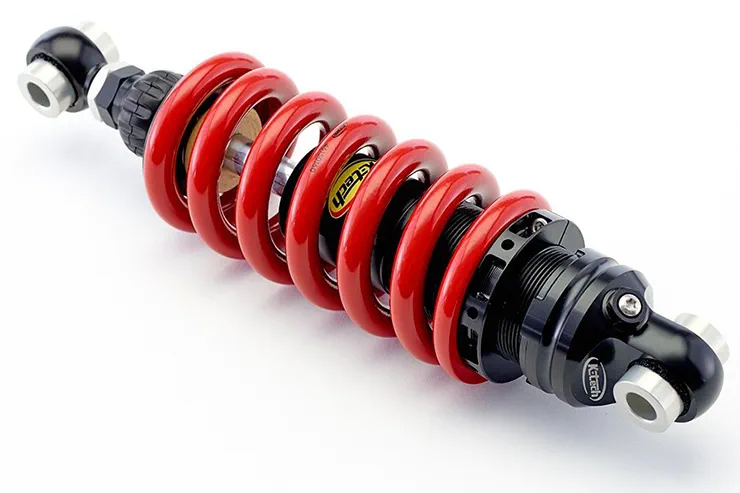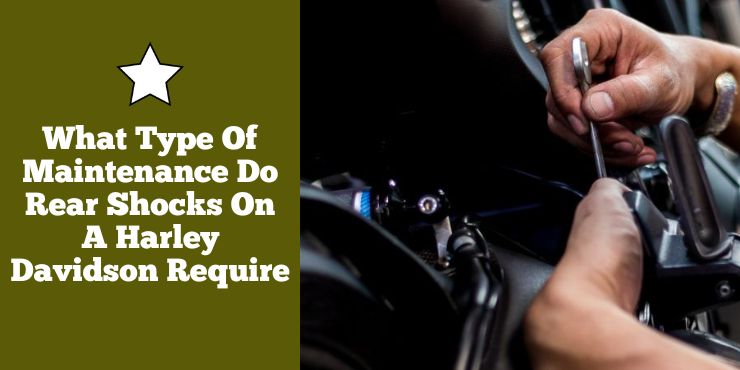Maintaining your Harley-Davidson is critical for keeping it running, and this includes taking care of the rear shocks. It can be a daunting task, but understanding what maintenance your Harley-Davidson rear shocks require will keep your bike in top condition and make sure you get the most out of your ride.
Rear shocks on a Harley-Davidson require periodic inspections for leaks, wear, and correct pressure (for air shocks). Adjusting preload settings as needed can help maintain performance.
In this article, you will learn the details of what maintenance your Harley-Davidson rear shocks need to keep them in good shape. So, if you’re ready to get the most out of your bike, read on to find out what type of maintenance your Harley-Davidson rear shocks need.
Rear shocks for Harley-Davidson motorcycles
Rear shocks are an important part of a Harley-Davidson bike’s suspension system. These components play a key role in providing the comfortable and controlled ride that Harley-Davidson is known for. They absorb shocks and vibrations from the roar surface to give a superior riding experience. Harley-Davidson is a brand known for its iconic bikes and understanding the definition and properties of rear shocks will help you better understand the engineering excellence behind these splendid machines.
>>> Click here to read our review of the Best Rear Shocks For Harley-Davidson <<<
Rear shocks or also known as shock absorbers or rear suspensions are part of the Harley-Davidson bike’s suspension system that primarily handles the vertical movement of the rear wheel. The rear shocks work in conjunction with the front forks and provide a balanced and stable ride by absorbing and dissipating the impact energy from uneven road surfaces, potholes, bumps, and other obstacles. These shocks play a vital role in maintaining the tire’s contact with the road, optimizing traction, and ensuring rider comfort and safety.
Harley-Davidson’s rear shocks are designed with specific properties in mind to cater to the brand’s distinctive riding experience and the preferences of its riders. Some of the key properties of rear shocks for Harley-Davidson bikes include adjustability, durable construction, iconic styling, ease of maintenance, and more.
Many Harley-Davidson models come with adjustable rear shocks, allowing riders to easily fine-tune the suspension to suit their individual preferences and riding conditions. Adjustable rear shocks typically feature settings for preload, compression, and rebound damping, allowing riders to tailor the suspension’s response based on their weight, riding style, and terrain.
Rear shocks in Harley-Davidson bikes often feature a coilover design where a coil spring surrounds the shock body. The design provides efficient suspension travel and dampening capabilities, ensuring a smooth and controlled ride.
Rear shocks for Harley-Davidson bikes are built to withstand the rigors of long-distance riding and various road conditions. The components are constructed using high-quality materials, ensuring durability and reliability throughout the motorcycle’s life.
The company places great emphasis on ride comfort and the rear shocks are no exception. The rear shocks are engineered to deliver a plush and comfortable ride, reducing rider fatigue during long journeys. Moreover, since the company is known for its iconic aesthetics, the rear shocks have been designed in ways to complement the overall look of the bikes. Many Harley-Davidson models come with chrome or blacked-out finishes that add to the bike’s distinctive appeal.
Rear shocks for Harley-Davidson bikes are specially tuned to match the unique characteristics of each model. The suspension tuning considers factors like the bike’s weight, frame geometry, and intended riding style. These factors provide a ride that aligns with the brand’s spirit of freedom and individuality. These rear shocks are engineered for easy maintenance, which allows riders to perform routine checks, cleaning, and lubrication without much effort.

What type of maintenance do rear shocks on a Harley-Davidson require?
Maintaining the rear shocks of your Harley-Davidson bike is important for a smooth and safe ride. Rear shocks play a key role in absorbing shocks from the ride and provide a controlled suspension. For anyone with a Harley-Davidson bike, knowing what type of maintenance do rear shocks on a Harley-Davidson require will be important. Knowing the essential maintenance steps will help ensure the longevity and optimal performance of your rear shocks. Here is what type of maintenance do rear shocks on a Harley-Davidson require, guiding you to keep your rear shocks in top-notch condition.
#1. Visual inspection
Performing regular visual inspections of your rear shocks will help identify any signs of wear, damage, or potential issues before they become major issues. To conduct a thorough visual inspection, you will need to check for oil leaks, examine mounting hardware, inspect springs, observe suspension action, and check adjustability features.
Inspect the rear shocks for any signs of oil leakage or damp spots around the shock body or seals. Oil leaks will indicate a worn-out seal or internal damage and should be addressed promptly. Make sure that all mounting bolts, bushings, and washers are secure and free from signs of damage or corrosion. Tighten any loose bolts to the manufacturer’s recommended torque settings.
Look for any cracks, deformations, or signs of rust on the coil springs. Damaged springs can affect the suspension’s performance and must be replaced if needed. Bounce the rear of the bike gently and observe the suspension action. The rear shocks should rebound smoothly and without any clunking or excessive noise. If your rear shocks are adjustable, check that the adjustment knobs or settings are functioning correctly and not seized or damaged.
#2. Cleaning
Regular cleaning will help keep your rear shocks free from any dirt, grime, and road debris, ensuring optimal performance and longevity. To clean your rear shocks, you’ll need to wash them, remove debris, clean the adjustability features, and dry them thoroughly.
Make use of a mild soap solution and a soft cloth or sponge for cleaning the external surfaces of the rear shocks. Avoid using any harsh chemicals or abrasive materials that might damage the finish. Clean the areas around the rear shocks to remove any mud, dirt, or debris that might be trapped between the shock body and other components.
If the rear shocks are adjustable, you should clean the adjustment knobs or settings to make sure there is a smooth operation. After cleaning, you should ensure that the rear shocks are completely dry before moving on to other maintenance steps.
#3. Lubrication
Proper lubrication is important for the smooth functioning of the rear shocks and for preventing premature wear. To lubricate the rear shocks, you will need to grease the mounting bolts, lubricate the adjustability feature, and inspect the seals.
First, you need to apply a small amount of high-quality grease to the mounting bolts and bushings to reduce friction and ensure proper torque. If your rear shocks are adjustable, you need to apply a suitable lubricate to the adjustment knobs or settings to ensure easy and smooth operation. If the rear shocks have exposed seals, you must inspect them for any signs of wear or damage. If needed, you should apply a light coat of silicone-based lubricant to the seals to maintain their integrity.
Make sure that you are referring to your Harley-Davidson bike’s owner’s manual or the manufacturer’s guidelines for specific maintenance instructions and recommended lubricants. Incorporate rear shock maintenance into your regular motorcycle maintenance schedule. Performing these tasks at regular intervals, such as during oil changes, will help keep the rear shocks in top condition. If you’re noticing any significant damage, oil leaks, or other issues during the visual inspection, it would be best to have a qualified mechanic or authorized Harley-Davidson service center inspect and address the problem.
Fine-tune and adjustment as part of regular maintenance of rear shocks
For Harley-Davidson riders, achieving the perfect balance of comfort and performance is important for an enjoyable journey on the road. The rear shocks play a significant role in achieving this balance by absorbing road imperfections and providing a smooth ride. Harley-Davidson rear shocks come with various adjustment options, allowing riders to fine-tune the suspension according to individual preferences and riding conditions. Here are some of the maintenance steps that you should carry out if you need to fine-tune and adjust rear shocks, helping you achieve the ideal performance.
#1. Adjustment of ride height
Adjusting the right height of your rear shocks can greatly impact the handling and stability of your Harley-Davidson bike. Lowering or raising the ride height can help riders achieve better control and improve their confidence on the road. The two ways to adjust the ride height include lowering the ride height and raising the ride height.
If you prefer a lower ride height, you should install shorter shocks or adjust the preload settings to compress the springs slightly. Lowering the rear suspension might improve stability during slow-speed maneuvers. Meanwhile, for riders who desire a higher ride height, installing longer shocks or adjusting the preload settings to extend the springs can achieve this effect. Raising the rear suspension might enhance ground clearance and allow better handling on rough roads.
#2. Adjustment of spring preload
Spring preload adjustment allows riders to easily customize the stiffness or softness of their rear shocks to match their weight and riding style. Proper spring preload makes sure that the suspension compresses and rebounds appropriately for optimal comfort and performance. To adjust the spring preload, you can either use a preload adjustment knob or use a C-spanner or wrench.
Many Harley-Davidson rear shocks come with an external preload adjustment knob. Turning the knob clockwise will increase preload (stiffen the suspension) while turning it counterclockwise will decrease preload (soften the suspension).
Some rear shocks might need you to use a C-spanner or wrench to adjust the preload. Insert the tool into the preload collar and turn it accordingly to achieve the desired setting.
#3. Adjustment of compression and rebound
Adjusting the compression and rebound damping of your rear shocks allows you to fine-tune the suspension’s response to different road conditions and riding styles. Compression damping controls how quickly the shock compresses when encountering bumps. Meanwhile, rebound damping will control how quickly the shock extends after compression. To adjust compression and rebound, you can make use of either clicker adjusters or internal adjusters.
Many advanced rear shocks feature external clicker adjusters. Turning the clicker knob clockwise increases damping (slows down compression or rebound). Meanwhile, turning it counterclockwise decreases damping (speeds up compression or rebound). Some rear shocks have internal adjusters that need disassembling the rear shock to access. Adjusting internal damping might require professional assistance or specialized tools.
Before you make any adjustments, you should note down the initial settings of your rear shocks. This will allow you to revert to the original settings if needed. When you’re adjusting ride height, preload, or damping, you should make small and incremental changes to gauge their impact on the ride. Avoid making drastic adjustments all at once. You must refer to your bike’s owner’s manual or the manufacturer’s guidelines to get specific adjustment instructions and recommended settings. If you aren’t sure about adjusting your rear shocks, it would be best to seek assistance from a qualified mechanic or authorized Harley-Davidson service center.

Symptoms that you need to replace the rear shocks on your Harley-Davidson bike
As a Harley-Davidson rider, you cherish the open road and the freedom that comes with it. Rear shocks play a vital role in giving you just that, absorbing bumps and vibrations from the road. To ensure that you continue to get a smooth and safe ride, it’ll be essential to keep your motorcycle’s rear shocks in optimal condition. At times, regular maintenance and trying to fix the issue might not be enough, and replacing the rear shocks might be the only way forward. Over time, these components might wear out, affecting your ride quality and handling. You need to know the signs that signal that you need to replace the rear shocks. Here are some of the symptoms that indicate it is time to replace the rear shocks on your Harley-Davidson bike.
#1. Excessive bouncing or bottoming out
One of the most apparent signs that your rear shocks need replacement is excessive bouncing or bottoming out. When you hit a bump or pothole, the rear end of your bike should compress and then rebound smoothly. If you notice that your motorcycle bounces excessively after encountering road irregularities or bottoms out on smaller bumps, it’ll likely be that the rear shocks are no longer providing ample dampening and support.
#2. Reduced ride comfort
Harley-Davidson motorcycles are known for their smooth and comfortable rides. If you experience a decrease in ride comfort and find yourself feeling every bump and imperfection on the road, it might be a sign of worn-out rear shocks. Deteriorated shocks cannot effectively absorb vibrations, resulting in a jarring and less enjoyable riding experience.
#3. Uneven tire wear
Pay close attention to your rear tire wear pattern. If you notice uneven wear or scalloping on the rear tire, it might be an indication of suspension issues, including work-out rear shocks. Faulty rear shocks can lead to inconsistent weight distribution on the rear tire, resulting in uneven tire wear.
#4. Leaking oil or damaged seals
Another common symptom that might signal the need for new rear shocks is the presence of leaking oil or damaged seals. You must look for signs of oil leakage or damp spots around the shock body or seals. Damaged seals can cause oil to leak out, compromising the rear shock’s performance and leading to reduced dampening capabilities.
#5. Excessive noise
Unusual noises coming from your rear shocks can be an indicator of internal damage or worn-out components. You should listen for clunking, rattling, or squeaking noises when going over bumps or during compression and rebound. These noises might suggest the need for rear shock replacement.
#6. Rear end sagging
A noticeable sag or lowering of the rear end of your Harley-Davidson bike might indicate weakened or worn-out rear shocks. Sagging rear shocks not only affect the ride height but also compromise the handling and stability of the bike.

Different types of rear shocks for Harley-Davidson
When it comes to Harley-Davidson motorcycles, comfort, control, and handling are paramount. The rear suspension plays a major role in achieving these qualities by absorbing shocks and providing a smooth ride. Harley-Davidson offers various rear shocks that suit different riding styles and preferences. Here are the most popular types of rear shocks for Harley-Davidson bikes.
Twin shocks
Twin shocks or also known as dual shocks or dual suspension are a traditional rear suspension setup found on many Harley-Davidson bikes. As the name suggests, the twin shocks system employs two individual shock absorbers, each on one side of the rear wheel.
Twin shocks come with a classic and iconic appearance that complements the retro style of many Harley-Davidson models. They offer a nostalgic touch and maintain the vintage appeal of the motorcycle. Twin shocks are well-proven and offer reliable performance, providing adequate comfort and handling for most riders’ needs. Since twin shocks are a simpler design with fewer moving parts, they’re generally easier to maintain and service.
Twin shocks might have limited adjustability options compared to more advanced suspension systems, which might not suit riders with specific performance preferences. On rough or uneven roads, twin shocks might not provide the same level of adjustability and ride comfort as other advanced systems.
Air adjustable shocks
Air adjustable shocks or also known as air shocks make use of compressed air as the primary means of suspension adjustment. These rear shocks allow riders to fine-tune the suspension’s firmness or softness by varying the air pressure.
Air adjustable shocks offer a high level of customization, allowing riders to adjust the suspension according to their weight, riding style, and road conditions. With the ability to adjust the air pressure, riders can enjoy a more comfortable ride, especially during long journeys or on different road surfaces. Properly adjusted air shocks can improve the bike’s handling, offering better stability and responsiveness.
Air shocks provide regular maintenance to ensure the air pressure is at the desired level and that there are no leaks in the system. Setting up air shocks for optimal performance might require some trial and error to find the right air pressure for individual riders.
Coilover shocks
Coilover shocks or also known as coilover suspension use a coil spring wrapped around the shock absorber to provide suspension travel and dampening.
Coilover shocks often come with adjustable preload settings, allowing riders to fine-tune the suspension’s sag and responsiveness based on their weight and riding preferences. These shocks are known for their durability and ability to handle varying road conditions effectively. The combination of coil springs and shock absorbers, delivers a smooth and controlled ride, enhancing overall comfort.
Riders may need to find the right balance between stiffness and comfort by adjusting the preload to suit their preferences. Regular inspection and maintenance are needed to ensure the coilover shocks continue to perform optimally.
FAQ
What type of maintenance do rear shocks on a Harley Davidson require?
Harley Davidson rear shocks require regular maintenance in order to ensure they are functioning properly and providing a comfortable ride. This includes checking for wear and tear, lubricating all moving parts, and adjusting the preload settings. It’s also important to check the air pressure in the shocks and replace any worn out parts.
How often should I perform maintenance on my Harley Davidson rear shocks?
It is recommended to perform maintenance on your Harley Davidson rear shocks every 6 months or 5,000 miles, whichever comes first. This will help to ensure the shocks are in good condition and performing optimally.
What are the consequences of not performing regular maintenance on my Harley Davidson rear shocks?
If regular maintenance is not performed on your Harley Davidson rear shocks, there is an increased risk of failure or damage. This can lead to premature wear and tear, performance issues, and even a potential accident. It is important to perform regular maintenance to ensure your shocks are in good condition and ready for the road.
>>> Read more about Rear Shocks for Harley-Davidson <<<

